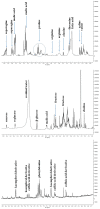Characterization of Health Beneficial Components in Discarded Leaves of Three Escarole (Cichorium endivia L.) Cultivar and Study of Their Antioxidant and Anti-Inflammatory Activities
- PMID: 37507941
- PMCID: PMC10376668
- DOI: 10.3390/antiox12071402
Characterization of Health Beneficial Components in Discarded Leaves of Three Escarole (Cichorium endivia L.) Cultivar and Study of Their Antioxidant and Anti-Inflammatory Activities
Abstract
Plants of genus Cichorium (Asteraceae) can be used as vegetables with higher nutritional value and as medicinal plants. This genus has beneficial properties owing to the presence of a number of specialized metabolites such as alkaloids, sesquiterpene lactones, coumarins, unsaturated fatty acids, flavonoids, saponins, and tannins. Cichorium endivia L., known as escarole, has achieved a common food status due to its nutritionary value, bitter taste, and the presence of healthy components, and is eaten cooked or raw in salads. Presently, wastes derived from the horticultural crops supply chain are generated in very large amounts. Vegetable waste comprises the discarded leaves of food sources produced during collection, handling, transportation, and processing. The external leaves of Cichorium endivia L. are a horticultural crop that is discarded. In this work, the phytochemical profile, antioxidant, and anti-inflammatory activities of hydroalcoholic extract obtained from discarded leaves of three cultivars of escarole (C. endivia var. crispum 'Capriccio', C. endivia var. latifolium 'Performance' and 'Leonida') typical horticultural crop of the Campania region were investigated. In order to describe a metabolite profile of C. endivia cultivars, the extracts were analysed by HR/ESI/Qexactive/MS/MS and NMR. The careful analysis of the accurate masses, the ESI/MS spectra, and the 1H NMR chemical shifts allowed for the identification of small molecules belonging to phenolic, flavonoid, sesquiterpene, amino acids, and unsaturated fatty acid classes. In addition, the antioxidant potential of the extracts was evaluated using cell-free and cell-based assays, as well as their cytotoxic and anti-inflammatory activity. All the extracts showed similar radical-scavenging ability while significant differences between the three investigated cultivars emerged in the cell-based assays. The obtained data were ascribed to the content of polyphenols and sesquiterpenes in the extracts. Accordingly, C. endivia by-products can be deemed an interesting material for healthy product formulations.
Keywords: Cichorium endivia L.; HRESIMS; NMR; anti-inflammatory; antioxidant; cultivar; green extraction; waste valorisation.
Conflict of interest statement
The authors declare no conflict of interest.
Figures










Similar articles
-
The impact of sesquiterpene lactones and phenolics on sensory attributes: An investigation of a curly endive and escarole germplasm collection.Food Chem. 2016 May 15;199:238-45. doi: 10.1016/j.foodchem.2015.12.002. Epub 2015 Dec 5. Food Chem. 2016. PMID: 26775966
-
Anti- and pro-oxidant water soluble activity of Cichorium genus vegetables and effect of thermal treatment.J Agric Food Chem. 2002 Jul 31;50(16):4696-704. doi: 10.1021/jf020123y. J Agric Food Chem. 2002. PMID: 12137499
-
First Report of a New Leaf Spot Caused by Plectosphaerella cucumerina on Field Grown Endive (Cichorium endivia) in Italy.Plant Dis. 2013 Jun;97(6):848. doi: 10.1094/PDIS-12-12-1168-PDN. Plant Dis. 2013. PMID: 30722646
-
Health Benefits of Key Constituents in Cichorium intybus L.Nutrients. 2023 Mar 8;15(6):1322. doi: 10.3390/nu15061322. Nutrients. 2023. PMID: 36986053 Free PMC article. Review.
-
Chemical constituents and their pharmacological activities of plants from Cichorium genus.Chin Herb Med. 2020 May 15;12(3):224-236. doi: 10.1016/j.chmed.2020.05.001. eCollection 2020 Jul. Chin Herb Med. 2020. PMID: 36119016 Free PMC article. Review.
Cited by
-
Chemical Profiling, Antioxidant, and Anti-Inflammatory Activities of Hyoseris radiata L., a Plant Used in the Phytoalimurgic Tradition.Antioxidants (Basel). 2024 Jan 17;13(1):111. doi: 10.3390/antiox13010111. Antioxidants (Basel). 2024. PMID: 38247535 Free PMC article.
-
Anti-Proliferative Potential of Cynaroside and Orientin-In Silico (DYRK2) and In Vitro (U87 and Caco-2) Studies.Int J Mol Sci. 2023 Nov 21;24(23):16555. doi: 10.3390/ijms242316555. Int J Mol Sci. 2023. PMID: 38068880 Free PMC article.
-
Growth, Ecophysiological Responses, and Leaf Mineral Composition of Lettuce and Curly Endive in Hydroponic and Aquaponic Systems.Plants (Basel). 2024 Oct 11;13(20):2852. doi: 10.3390/plants13202852. Plants (Basel). 2024. PMID: 39458799 Free PMC article.
References
-
- Sareedenchai V., Zidorn C. Flavonoids as chemosystematic markers in the tribe Cichorieae of the Asteraceae. Biochem. Syst. Ecol. 2015;38:935–957. doi: 10.1016/j.bse.2009.09.006. - DOI
Grants and funding
LinkOut - more resources
Full Text Sources

